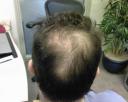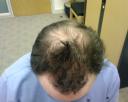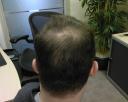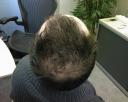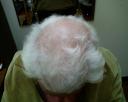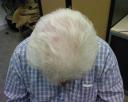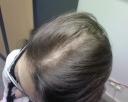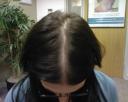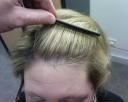12.01.2008
in Uncategorized
HAIR loss can be distressing but is a fairly common condition, particularly among men.

When it comes to hair loss, most of us will lose over 100 strands each day without noticing. That’s partly because the average scalp has about 100,000 hairs as well as the fact that for the most part, new hair growth matches hair loss.
When hair loss significantly exceeds hair growth, or when new hair shafts are significantly finer than those being replaced, you will eventually start to notice thinning or balding.
The commonest form of hair loss is known as androgenetic alopecia or “male pattern balding”. It affects all men to some degree, some earlier and some later. Women may also be affected although it tends to be milder and much less common. With men, hair is usually lost at the temples and the hairline recedes followed by thinning at the crown. It can start as early as the teens and by age 30 about a quarter of men are affected to some degree. By age 60 around two thirds of men are either bald or have a balding pattern.
In women, the frontal hairline tends to be maintained with thinning mainly affecting the top of the head and crown. A woman may notice her part becoming wider or her ponytail becoming thinner or simply that she can now see more of her scalp than before.
More than 55 per cent of women will notice mild degrees of hair loss as they age but only around 20 per cent of women suffer moderate or severe loss.
What causes hair loss?
Androgenetic alopecia is largely determined by genes and hormones, in particular, testosterone levels. Other causes of hair loss or balding include “traction” alopecia, where pulling the hair tightly back in ponytails and so on results in hair breakage and loss. Vigorous brushing, and overuse of harsh chemicals, dyes, curlers, hot irons and hairdryers can damage hair, making it brittle but unless the hair root is damaged, normal growth should continue.
The psychological condition “trichotillomania”, where people pull on or chew their hair when stressed, is another fairly uncommon cause of hair loss.
High fevers, severe viral infections, surgery and extreme emotional or physical stress are also associated with temporary hair loss.
Ringworm (a fungal infection) can cause hair loss if the scalp is affected. Chemotherapy, radiotherapy, burns and certain autoimmune conditions may also cause hair loss.
Hair thinning may result from eating disorders and poor nutrition. In addition, certain medications may also cause hair loss in some people
During pregnancy, women tend to shed less hair and the process of hair loss is delayed until several months after delivery.
Alopecia areata is a condition of unknown cause in which patchy, often recurrent hairloss occurs, usually followed by partial or full regrowth. Affected people are thought to be genetically predisposed.
What can be done?
Depending on the cause (if any) and degree of hair loss you have suffered, your doctor can advise you on treatment options. There are prescribed medications that can be applied to the scalp or taken orally. There is the option of hair transplantation, scalp reduction (removing part or all of the bald area of skin), wigs and “spray-on” hair. Some choose to wear hats or scarves while others prefer to shave it all off and live by the mantra that “bald is sexy”. One look at Yul Brynner is enough to convince me.
Question: Will my hair re-grow after chemotherapy or radiotherapy?
Answer: It usually takes from four to six weeks after finishing chemotherapy for the first fine hairs to reappear. By three to six months a reasonable thatch will have grown which may be slightly different in colour and texture to your original hair. Hair may take from six to 12 months to regrow after radiotherapy. Depending on the dose and duration of radiation treatment the quality, quantity and speed of hair regrowth may vary. If the dose of radiation has been very high, hair may not regrow or growth may be patchy.
Do you have Hair Loss Problems, read our Hair Loss Help





